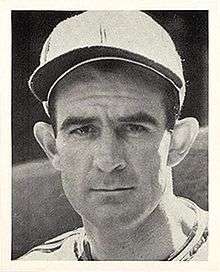Elden Auker
| Elden Auker | |||
|---|---|---|---|
 | |||
| Pitcher | |||
|
Born: September 21, 1910 Norcatur, Kansas | |||
|
Died: August 4, 2006 (aged 95) Vero Beach, Florida | |||
| |||
| MLB debut | |||
| August 10, 1933, for the Detroit Tigers | |||
| Last MLB appearance | |||
| September 20, 1942, for the St. Louis Browns | |||
| MLB statistics | |||
| Win–loss record | 130–101 | ||
| Earned run average | 4.42 | ||
| Strikeouts | 594 | ||
| Teams | |||
| Career highlights and awards | |||
| |||
Elden le Roy Auker (September 21, 1910 – August 4, 2006) was an American right-handed pitcher in Major League Baseball (MLB) noted for his submarine pitching style.
Athletic career
Auker was born and raised in Norcatur, Kansas, the son of Fred and Florence Auker. He attended college at Kansas State University in Manhattan, Kansas, where he was a brother of Phi Sigma Kappa. Called by former Kansas State University President James McCain, "the greatest all-around athlete in Kansas State history," Auker won nine varsity letters – three each in baseball, basketball and football during his college career from 1929–1932.[1] He was first-team All-American in baseball and All-Big Six Conference in baseball, football, and basketball.[1] In football, Auker starred at quarterback, was named second team All-American by Grantland Rice and was offered a $6,000 contract by the Chicago Bears. The Bears sent Bronko Nagurski to Manhattan to try to convince him to join the team. Auker turned down the Bears, however, to pitch for the Detroit Tigers.
During his ten-year Major League career, Auker played with the Tigers, Boston Red Sox and St. Louis Browns. The first batter Auken faced was Babe Ruth, whom he struck out on four pitches. Auker was the last living pitcher to have faced Ruth.[2] While with Detroit, Auker went to consecutive World Series, in 1934 and 1935. In the 1934 Series against the St. Louis Cardinals, Auker was the winning pitcher in Game 4, but the loser to Dizzy Dean in the decisive Game 7. The next season, Auker led the American League in winning percentage with an 18–7 record. In the 1935 Series against the Chicago Cubs, Auker started Game 3, which Detroit won in extra innings, and the Tigers went on to win the Series four games to two.
During the 1935 World Series, Auker was interviewed by a young Cubs broadcaster, Ronald Reagan. When they met after Reagan had been elected governor of California, Reagan told him, "You probably won't remember me, but I'll remember you as long as I live." The radio interview, Reagan said, "was my first big break."[2]
Before the 1939 season, Auker was traded by Detroit to the Red Sox for Pinky Higgins and Archie McKain. That season was Ted Williams's rookie year in Boston, and the two would develop what became a lifelong friendship during the season. However, Auker chafed playing under Red Sox manager Joe Cronin, and his 9–10 record in the year was the lowest win total of any full season he played. Auker finished his career playing three seasons with the Browns (1940–1942). During the 1941 season, he gave up hits to Joe DiMaggio during two games of DiMaggio's record 56-game hitting streak.
Post baseball
Auker retired in 1943 so that he could contribute to the war effort. From 1943–1945, he worked on airplane and naval guns. From 1946 until 1975, Auker worked for Bay State Abrasives in Massachusetts, a company that made armaments and abrasive materials, retiring as the company president.[2]
He was inducted into the Kansas Sports Hall of Fame in 1969.[1]
Auker appeared at the last game played at Tiger Stadium on September 27, 1999. Auker spoke at the ceremony and told the crowd: "Never forget us, for we live on by those that carry on the Tiger tradition and who so proudly wear the olde English D."
In 2001, Auker wrote his memoirs, entitled Sleeper Cars and Flannel Uniforms with Tom Keegan. He died at age 95 in Vero Beach, Florida.[2]
Bibliography
- Elden Auker with Tom Keegan, Sleeper Cars and Flannel Uniforms: A Lifetime of Memories from Striking Out the Babe to Teeing it up With the President (ISBN 1-892049-25-2, 2001)
References
- 1 2 3 "Auker, Eldon Inducted 1969". Kansas Sports Hall of Fame. Retrieved November 19, 2012.
- 1 2 3 4 Schudel, Matt (April 6, 2006). "Depression-Era Submarine Pitcher Elden Auker". The Washington Post. Retrieved November 19, 2012.
External links
- Career statistics and player information from Baseball-Reference, or Fangraphs, or The Baseball Cube, or Baseball-Reference (Minors)
- Pitching in the Big League the Underhand Way by Jim Sargent
- New York Times Obituary
- Washington Post Obituary
- USA Today Obituary
- Coverage from the Wichita Eagle and Kansas.com